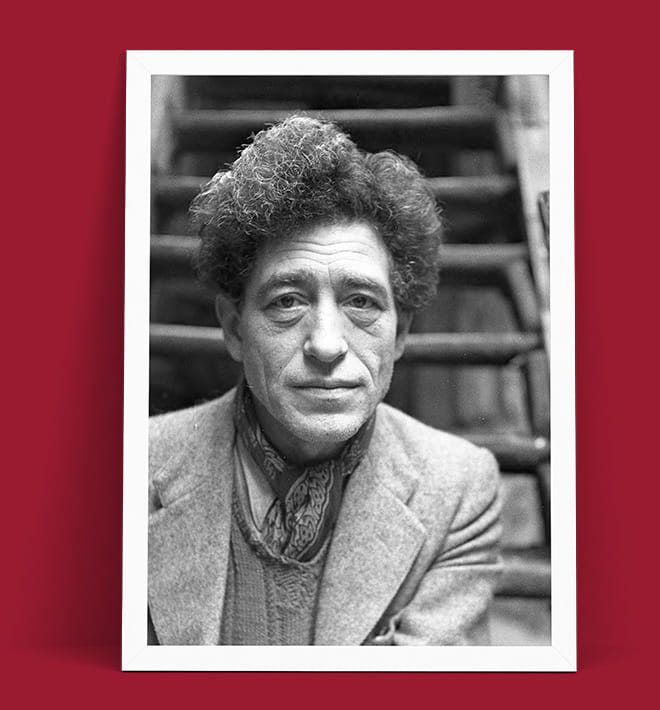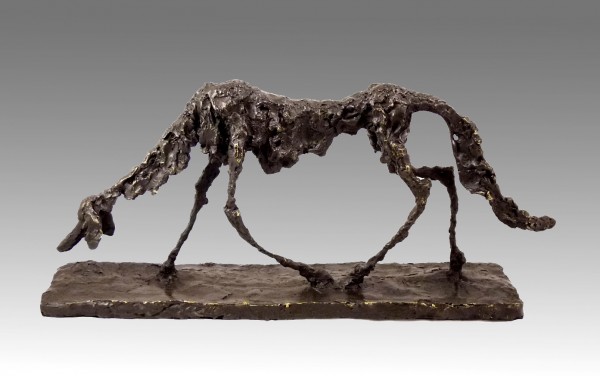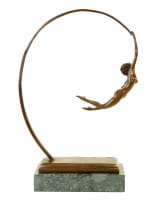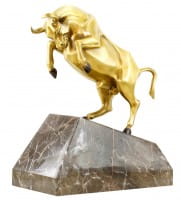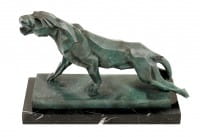Prices incl. VAT, free shipping worldwide
Ready to ship today,
Delivery time appr. 3-6 workdays










Product description
"The Dog - Le Chien - 1951 Bronze - Alberto Giacometti Sculptures"
| Height | 28 cm |
| Width | 47 cm |
| Length | 12 cm |
| Weight | 7 kg |
The Dog – Le Chien (1951) - Signed Alberto Giacometti
More than any of his other animal figures, The Dog reflects an intimate, almost autobiographical identification. Giacometti once stated that he saw in the dog a reflection of his own gait, his own solitary rhythm, his own sense of being adrift in the city streets. The bowed head, the elongated torso, the lean legs that stretch across the uneven base—all suggest a body both exhausted and enduring. This is not a pet, not a symbol of loyalty or companionship. It is an alter ego. It is the artist as walker, as survivor, as silent witness to the world. Among Alberto Giacometti Artwork, Le Chien stands as one of the most personal and emotionally resonant sculptures he ever created.
From the Valleys of Switzerland to the Void of Modernity
Alberto Giacometti was born on October 10, 1901, in Borgonovo, a remote village in the Swiss Val Bregaglia, near the Italian border. He grew up in a family steeped in art and Alpine stillness. His father, Giovanni Giacometti, was a respected post-impressionist painter who nourished his son's early fascination with visual form. Alberto began sculpting as a child, carving his first heads from plasticine by candlelight. In 1922, he moved to Paris, where he would become one of the most psychologically profound and formally radical artists of the twentieth century. The entire trajectory of Alberto Giacometti Artwork reflects a relentless and deeply personal search—not for the ideal, but for truth, tension, and presence.
1951: A Year of Walking Figures and Inner Silence
By 1951, Giacometti had entered the most intense phase of his postwar production. After returning to Paris from wartime exile in Switzerland, he became consumed by the problem of rendering human and animal presence in the emptiness of space. It was in this creative crucible that The Dog (Le Chien) was born. At once skeletal and monumental, the bronze figure emerged not as a naturalistic animal but as a vessel of psychological experience. This sculpture belongs to a crucial period in Giacometti Art, one that yielded many of the most iconic Giacometti Sculptures, including L'homme qui marche, La femme debout, and a series of haunting busts that seem to hover between existence and dissolution.
Bronze as Living Flesh and Wound
The rough, deeply worked surface of the bronze is one of Giacometti’s hallmarks. Here, it is particularly poignant. The dog's body appears as if corroded by time or memory—thin, torn, almost spectral. And yet, there is undeniable vitality in the form. Every ridge, every void, every subtle texture records the artist’s hand and hesitation. This refusal to polish or idealize is central to Giacometti Sculptures, where raw material becomes a language of truth. Bronze, traditionally used for its permanence and monumentality, is here turned into something ghostlike, vulnerable, human.
Walking Toward Nothingness
The sculpture is defined by motion—but not heroic, forward-reaching motion. The Dog does not leap or chase. It trudges. Its head droops, its tail barely follows, its limbs stretch as if resisting gravity. The act of walking becomes a metaphor not for progress but for endurance. In this slow, silent advance, Le Chien embodies the existential themes that pulse throughout Giacometti Art: isolation, repetition, the tension between physical presence and spiritual absence.
A Horizontal Departure from Verticality
Most Giacometti Sculptures are defined by a stark vertical orientation—standing men, walking women, elongated heads rising from narrow necks. The Dog is a rare exception. It moves horizontally, closer to the ground, more primitive, more elemental. This shift in direction reinforces the sense of humility and weariness. It is a creature not of ambition, but of persistence. It slinks across the base like a shadow, like a memory, like a residue of life that continues simply because it must.
The Animal That Mirrors the Human
Though it depicts a dog, the sculpture is deeply human. We see in its posture not only animal instinct, but emotional exhaustion. It reminds us of our own walks through silence, through uncertainty, through life. It is a figure that holds no narrative, no symbolism—only the gesture of forward motion, despite everything. It walks beside us, and in doing so, it becomes us. This mirroring effect is what elevates The Dog to one of the most profound works in all of Giacometti Art.
A Presence That Endures
The Dog – Le Chien (1951) by Alberto Giacometti is not just an animal in bronze. It is a self-portrait in disguise, a meditation in motion, a whisper of perseverance. In its silence lies its strength. In its roughness, its honesty. It speaks not of triumph, but of continuing. Of being. Of becoming. As one of the most haunting and poetic Giacometti Sculptures, it walks through time without destination—only with the quiet dignity of form that refuses to disappear.
Our advantages
free shipping
Worldwide free shipping
14 days money back
You can cancel your order
within 14 days
secure payment services
Paypal, Master Card, Visa, American Express and more

